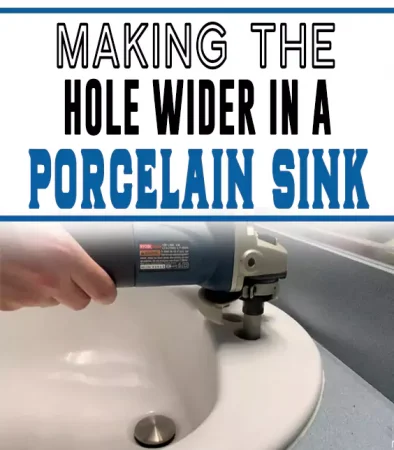You might be asking how to make a bigger hole in a porcelain sink without causing any crack or scratch. Here’s how to do it.
Though the best porcelain sinks come with pre-drilled holes, you may experience a problem while trying to install a new faucet in the sink. You may need to wider sink holes or create a new hole.
One known way to make a hole wider in a porcelain sink is drilling. However, you need to understand that porcelain is prone to shattering when concentrated force is given to a single area due to its density.
If you are not careful when drilling porcelain, it can crack.
Recommended reading: How to Cut a Hole in a Stainless Steel Sink.
Wearing down the porcelain with a grinder is also one way. Alternatively, you can cut a new hole in the sink with a diamond grit hole saw.

How To Make a Bigger Hole in A Porcelain Sink
1. Using a Diamond-Tipped Drill Bit
Material Requirements:
- A pair of gloves and safety goggles
- Coldwater
- Chalk pencil
- Diamond-tipped drill bit
Step 1: Outline the Sink Hole Work Area with a Chalk Pencil
After getting the necessary tools ready, your first task involves marking the hole with a pencil before drilling.
Outline the sinkhole boundary in your porcelain sink with your chalk pencil to quickly identify your drilling location.
Furthermore, consider wearing your pair of gloves and goggles before drilling for safety. The goggles protect your face and eyes from dust and harmful substances flying around, while the gloves protect your hands.
Now start drilling the porcelain sink with the minor diamond-tipped drill bits for desired results. Drill the sink from the center of the hole and ensure the drill bit moves in a clockwise motion.
Lastly, drill the sinkhole with care to avoid breakage and unexpected injuries.
Step 2: Rinse the Drill Bit with Cold Water
While drilling the porcelain sink, consider rinsing your drill bit with cold water every 10 to 15 seconds. Your sink is similar to a cold glass as both tend to crack under intense and continuous heat.
Continuous drilling will make the sink crack because the drill bit creates heat in motion. Rinsing with cold water at intervals keeps the heat temperature at a bearable limit to prevent breakage or chipping.
Step 3: Widen the Porcelain Sink Hole as Required
Consider changing the size of your drill bit as the hole start widening.
Widen the hole by drilling in a circular motion until it reaches the outlined boundary without applying pressure on the sink.
When it reaches the boundary, clean the debris and chalk pencil lines with a towel and rinse with cold water.
2. Using a Drill Bit with an Improvised Water Station
Material Requirements:
- A pair of gloves and goggles
- Empty bucket (Large)
- Diamond-tipped drill bit
- Chalk pencil
- 1/8 inch 8d nail
- Coldwater
Step 1: Put on your Gloves and Goggles
Consider protecting your hands and face before creating a bigger hole in your porcelain sink. Before you start drilling, put on your gloves and goggles to protect your eyes from dust and debris.
While moving your sink to an outdoor work area produces the best result, there is an alternative. You can also work indoors but cover the location with plastic tarps.
The plastic tarps prevent any spills with desirable results. After selecting your work location, place the bucket under the drilling location and start working on the improvised water station.
Step 2: Create a Makeshift Water Station
At first, get a gallon jug and fill it with cold water to create a makeshift station. Ensure your jug can sprinkle a constant stream of water on the sinkhole when you start drilling.
The regular flow of water ensures smooth and fast drilling without cracking or chipping. Create your water station by puncturing the gallon jug with the 8d nail. Puncture the gallon jug side and leave the nail until you start drilling.
Step 3: Start Drilling
Now that you’re ready to make a faucet hole larger, remove the nail from the jug. As the water spills on the area, start drilling in a circular motion. Place the bit on the spot gently and drill for 10-15 seconds at a time.
If you want to widen the porcelain sink existing hole with this method, you need an assistant. Now put someone on standby to steadily pour water on your work location while you drill. In addition, consider adding the stream of water in small quantities to prevent unnecessary splashing.
Step 4: Empty the Bucket
After creating your desired sink hole size, remove the bucket beneath and empty it before cleaning. Lastly, clean splashing residues with a soft cloth from the white sink and dry your sink.
3. Using Diamond-Tipped Hole Saw with Pilot Hole
Material Requirements:
- A pair of gloves and goggles
- Water
- Chalk pencil
- Diamond-tipped hole saw
- A piece of plywood
Step 1: Outline the Sink Hole work area with a Chalk Pencil
Your first task after getting the required materials is creating an outline on the sink. Furthermore, you can outline your hole size on the porcelain sink with a chalk pencil.
It’s time to separate your sink from the work area and set it aside. Place the piece of plywood in the work area and measure the sink’s hole size before wearing your safety gear.
Step 2: Drill Hole into the Plywood
Now that you have an outline on the plywood, it’s time to call your diamond-tipped hole saw into action.
After putting on your pair of gloves and goggles, start drilling a hole into the plywood with your diamond-tipped hole saw. Ensure that the saw follows the outline and drills with precision.
Step 3: Add Water to the Work Area
After creating a hole in the plywood, bring your sink back to the work area. Place the plywood over the outlined sinkhole and add water.
It is advisable to add little water that’ll keep the area wet for a seamless drill. Furthermore, a wet area minimizes the chances of unexpected accidents and ensures a faster drill.
Step 4: Start Drilling Hole
Create an outline on the sink with the chalk pencil before you start drilling. Place the diamond-tipped hole saw on the sink surface, follow the outline, and drill in a circular motion.
Consider applying a gentle approach and do not place too much bodyweight on the sink. Drill through the sink to make a bigger hole. In addition, the diamond-tipped hole saw is ideal for drilling because it is large and minimizes the chances of a crack.
While Enlarging the Porcelain Sink Hole
1. Place a cloth under the sink
Taking safety precautions is necessary against injuries when drilling a hole in a porcelain sink. The drilling process involves regular water on the sink, so you need a cloth to stop the spread.
Check my review to select the best under sink mat.
2. Put on a pair of gloves and goggles
The hole enlargement process involves drilling, and specks of dust can create vision problems without protection. So it would be best to get gloves and goggles to protect your hands and eyes from specks of dust.
3. Use a new diamond-coated bit
If you want to achieve the best possible result, consider drilling with a new diamond-coated bit. Using a new and sharp drill bit makes the process faster and smoother. A dull and old drill bit elongates the process and will likely cause cracks on your sink.
4. Drill gently
The best way to avoid cracks, chips, or unexpected accidents is to drill the sink with care. Do not apply too much pressure while drilling, especially on the edges. The machine applies the adequate force required for a successful drill.
Related Guide: How to Drill a Hole in a Cast Iron Sink.
Conclusion
We agree that making a large hole in a porcelain sink is difficult. However, it isn’t impossible. All you need to know is what materials you’re working with and how to work with them properly.
If you don’t take precautions properly, drilling for enlarging holes in a sink can cause vision difficulties due to dust grains.
Furthermore, consider drilling with a new diamond-coated bit if you want the finest possible results.
Using a new, sharp drill bit speeds up and smooths out the operation. I hope, now you’ll be able to make the whole wider in a porcelain sink.
